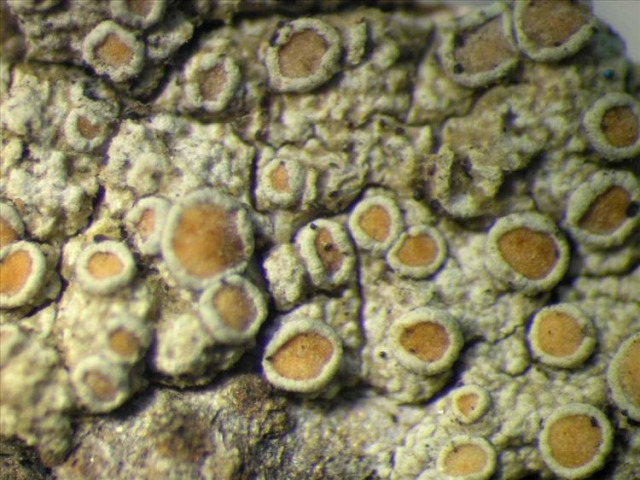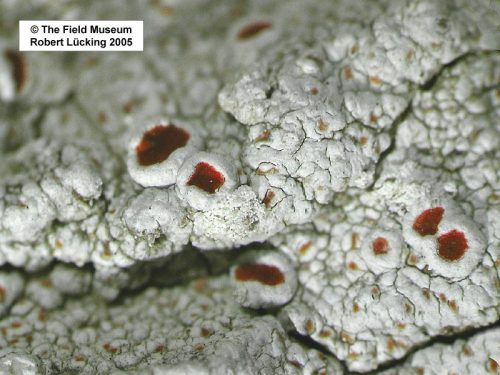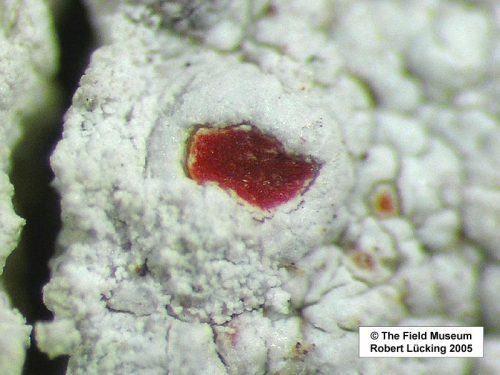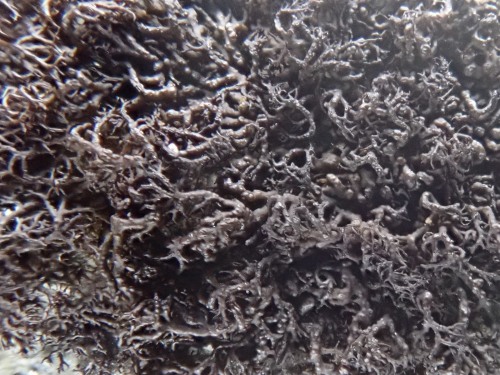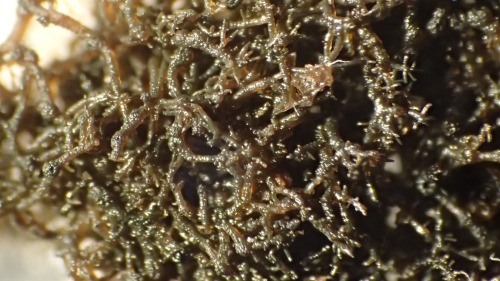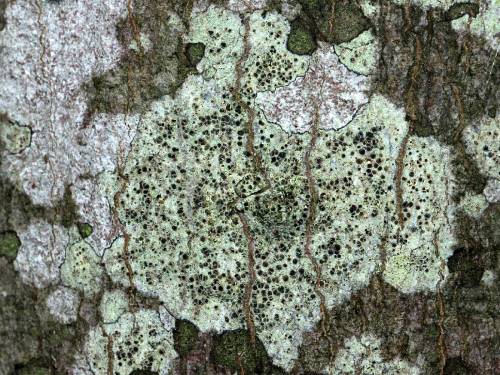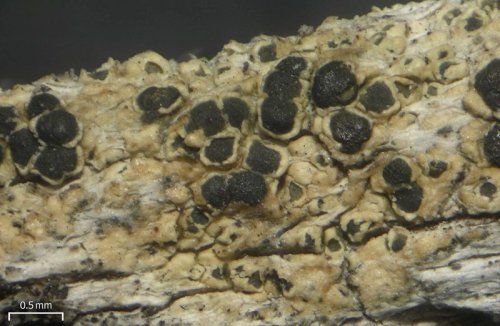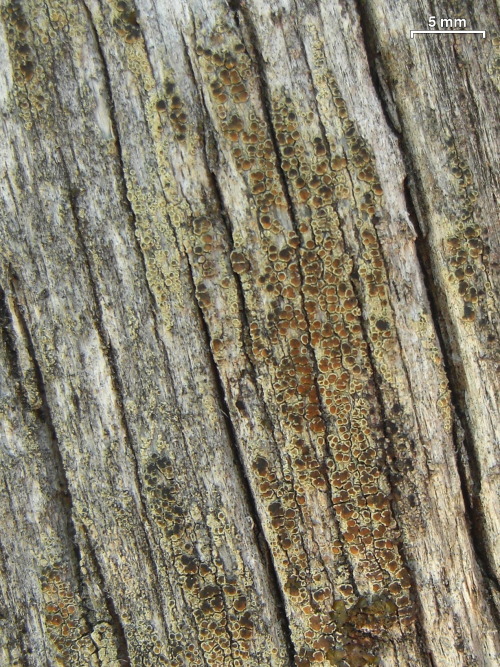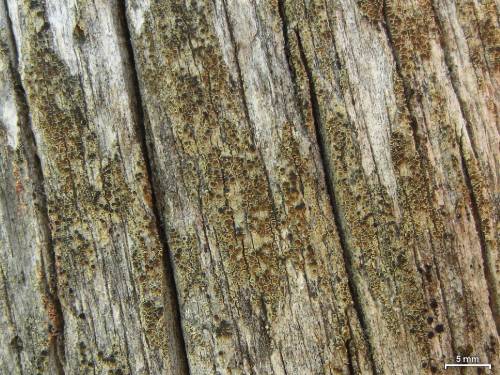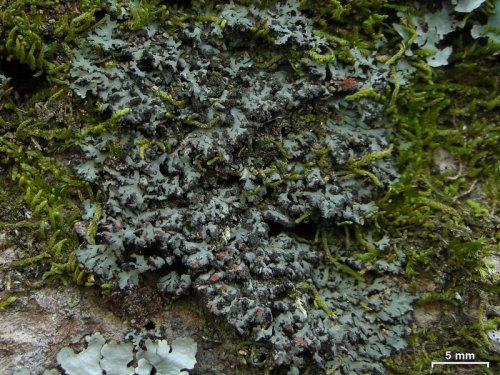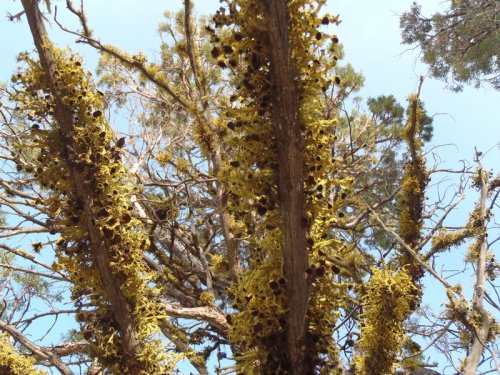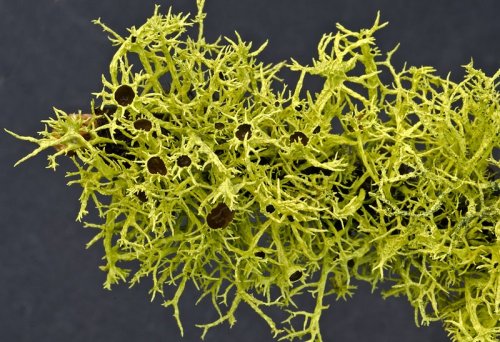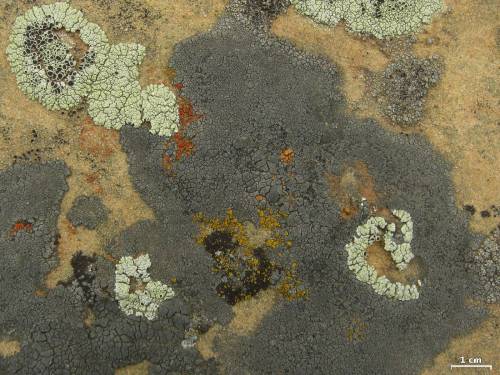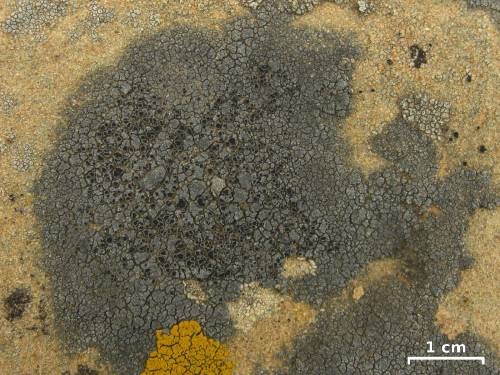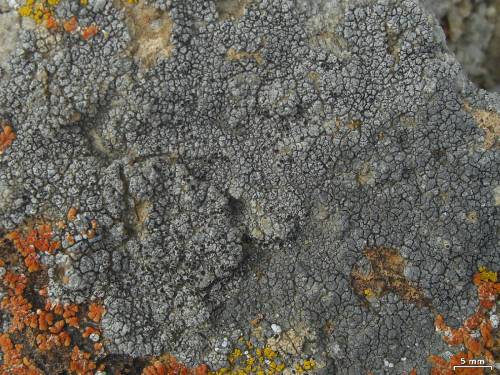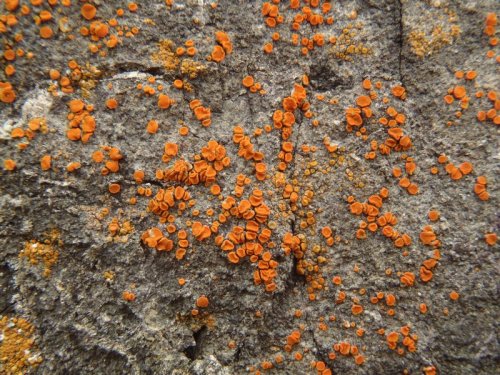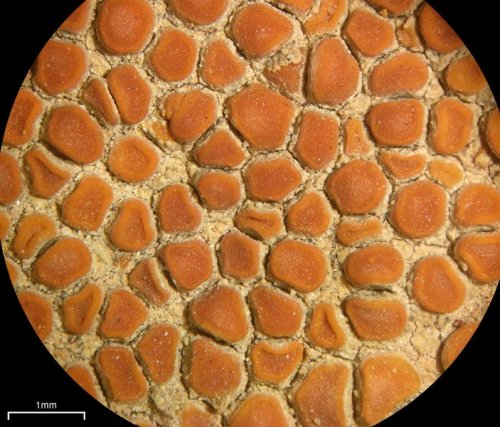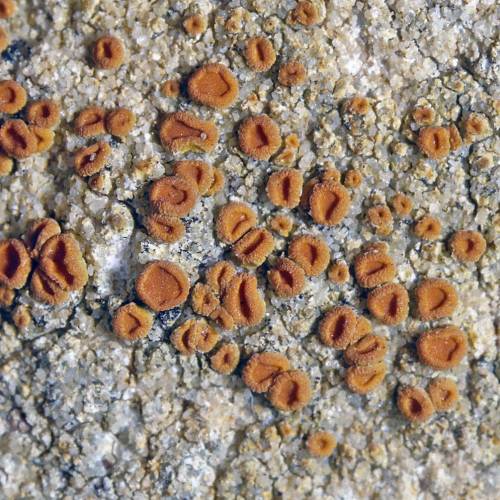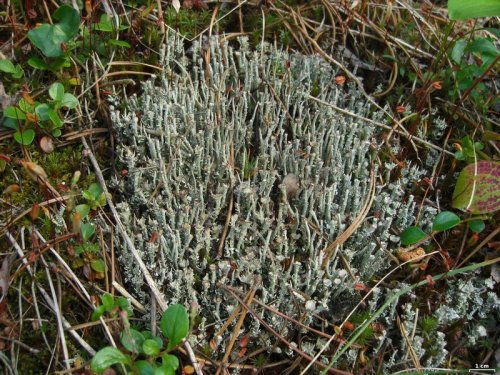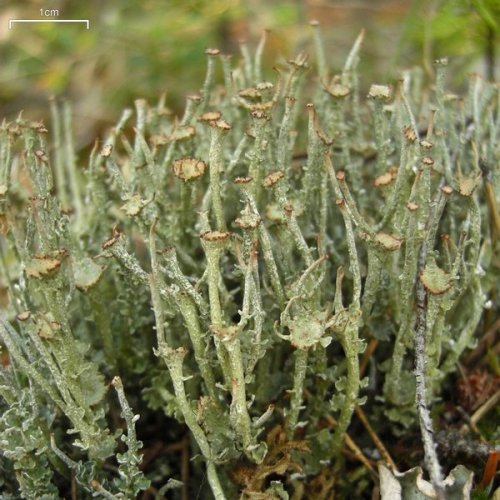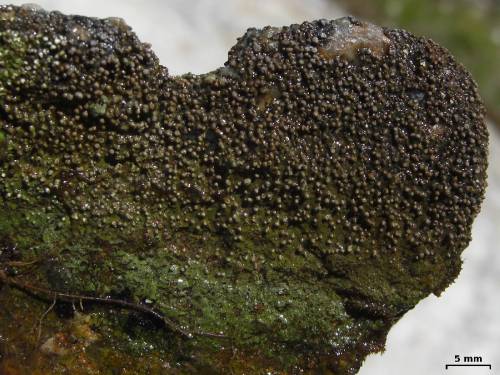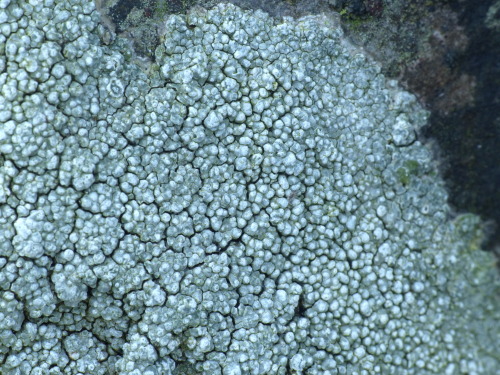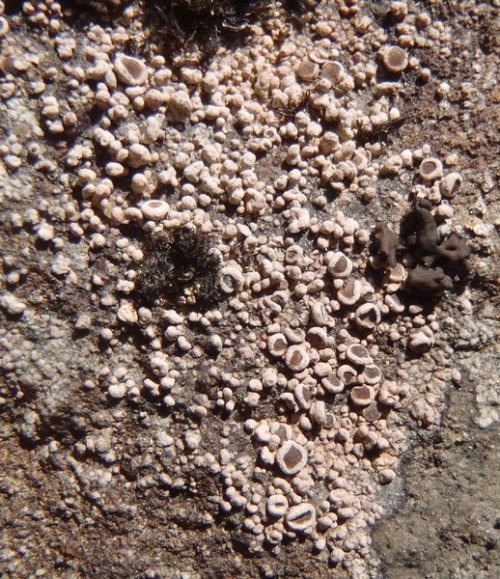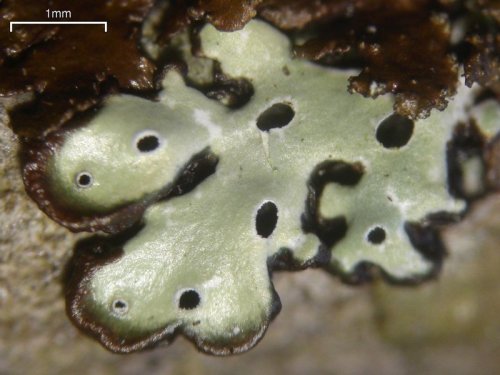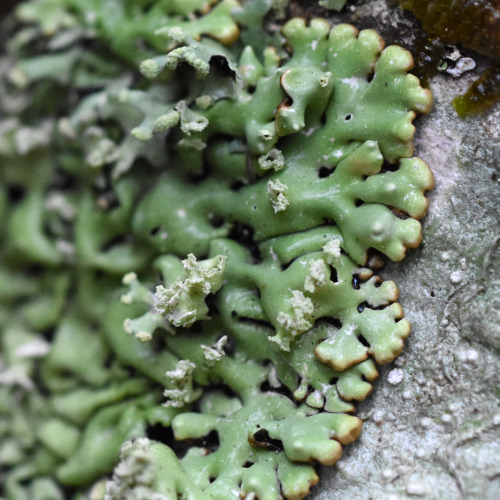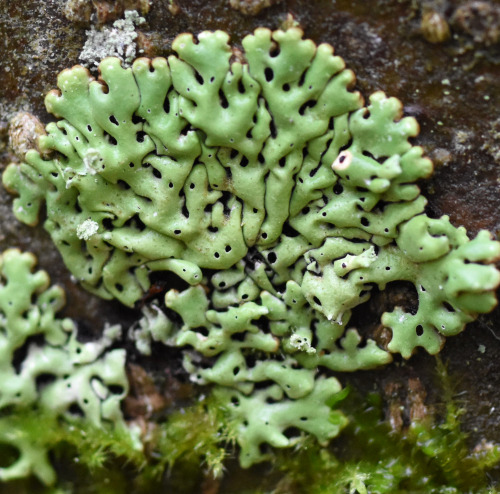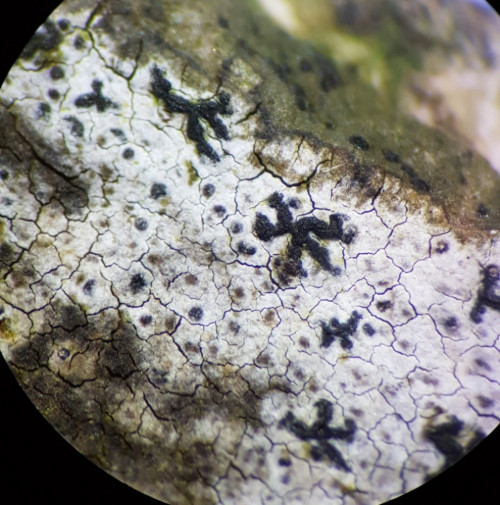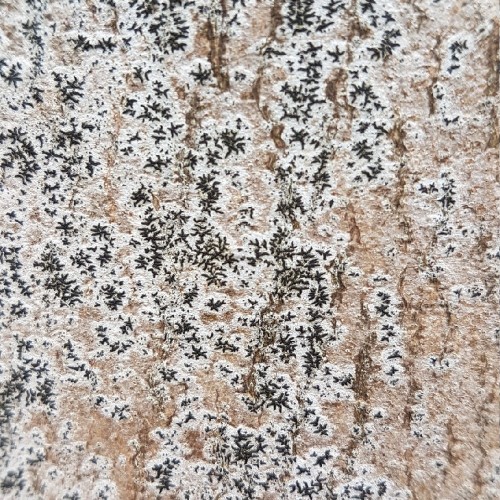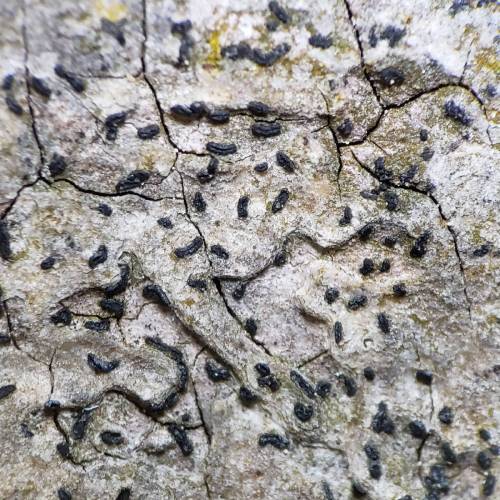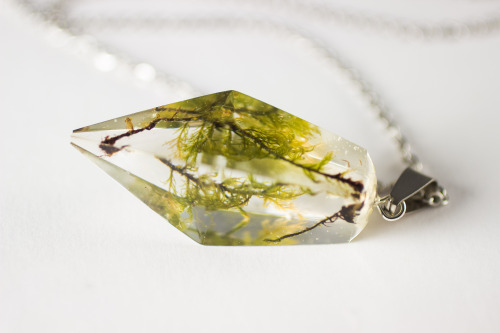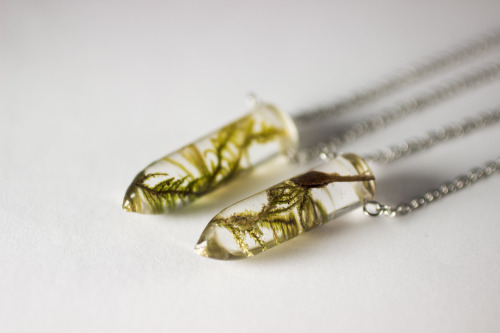#bryology



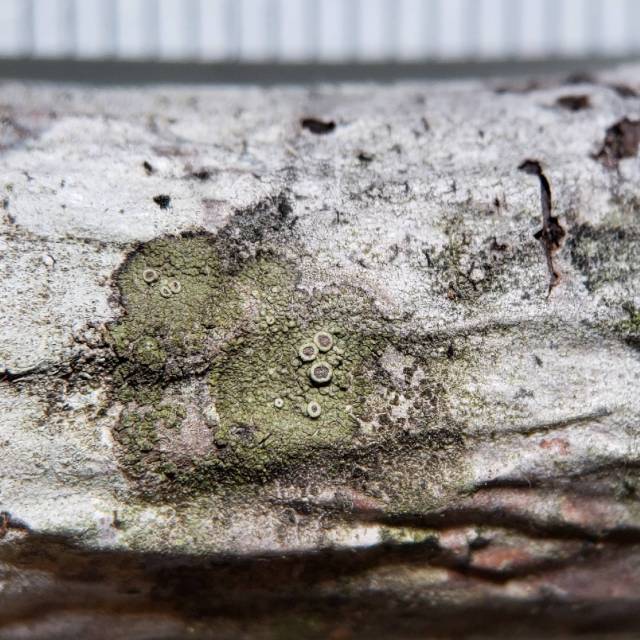
Maronea polyphaea
Um … anyone else having trouble uploading/editing multiple-picture-posts? Is this a my dumb internet thing? Or a new post-version thing? Ugh, annoying. I will try not to let it get me down and color my opinion of today’s lichen, M. polyphaea. This crustose lichen has a thin, wrinkled, gray-green thallus with black-disked apothecia. The surface is often coated in a thin layer of powdery pruina. M. polyphaea grows closely attached to smooth tree bark in the SW U.S. Pretty sure. There are records of it growing elsewhere, but the description I am reading is pretty specific about that range. IDK, a lot of things aren’t making sense to me today. But you know what does make sense? Falling in love with little dudes like this.
info:source








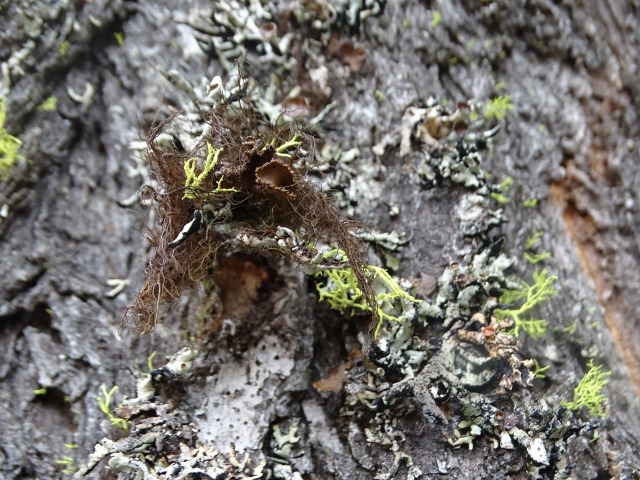

Nodobryoria abbreviata
Tufted foxtail lichen
I have been really thinking I need a haircut lately. I can’t pull off the long-haired, brunette look like N. abbreviata. This brittle, fruticose lichen grows on conifers in chaparral and coast-adjacent woodland. It has a reddish-brown, fruticose thallus, and flat, concolorous apothecia surrounded in a ciliate margin. Nododobryoria was only recognized as a sperate genus from Bryoria lichens in 1995 due to a difference in chemical composition and cellular structure. Goes to show you shouldn’t judge a lichen by its thallus–it’s what’s on the inside that counts!





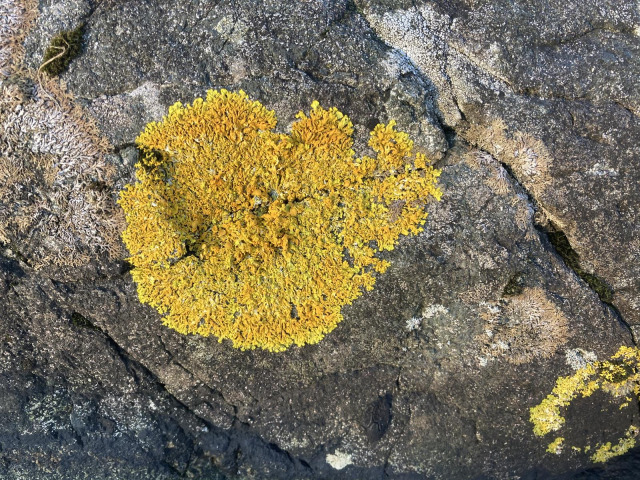

Xanthoria aureola
ok, before I get a bunch of messages and reblogs like “Oh! I’ve seen this! It’s all over my neighborhood!” I am gonna kill your hopes and dreams right now by saying what you are most likely seeing is Xanthoria parietina, which is super common pretty much everywhere and grows on just about everything. But, if your neighborhood happens to be a wind-swept, rocky, coastal habitat in Europe or northern Africa, this might actually be your guy! X. aureola is has a thick, golden-yellow to orange, foliose thallus made up of narrow, strap-shaped, overlapping lobes. It rarely produces apothecia, which are flat, round, and concolorous with the upper surface. It grows on nutrient-rich or siliceous rocks and cliffs along the seashore, and occasionally on walls and old wood.










Platismatia herrei
Herre’s ragged lichen, tattered rag lichen
Can you believe people have the gall to describe P. herrei as “ragged?” When it is probably the most stunning thing I have seen today? The nerve, honestly. This foliose lichen has long, thin lobes that grow straight-up or drooping over. The lobe edges are covered in a thick layer of isidia (clonal propagules containing both algal and fungal components). The upper surface is typically a pale gray or green, sometimes turning brown after prolonged sun exposure. The lower surface is patchy white, gray, and brown with few rhizines. P. herrei grows on conifers in the Pacific NW of North America. And is beautiful and perfect and not ragged even a little bit.
images:source|source|source|source|source
info:source










Diplotomma venustum
Venerating celebrities is out, venerating lichens is IN! Public figures will let you down and devastate you emotionally but you know who would never do that to you? D. venustum. They’re your unproblematic fave now. Deal with it.
This crustose lichen grows in thick, white rosettes dotted with black or chalky gray apothecia. It colonizes calcium-rich rocks and human-made surfaces in open areas of northern Africa, Asia, Europe, North America, and Greenland.




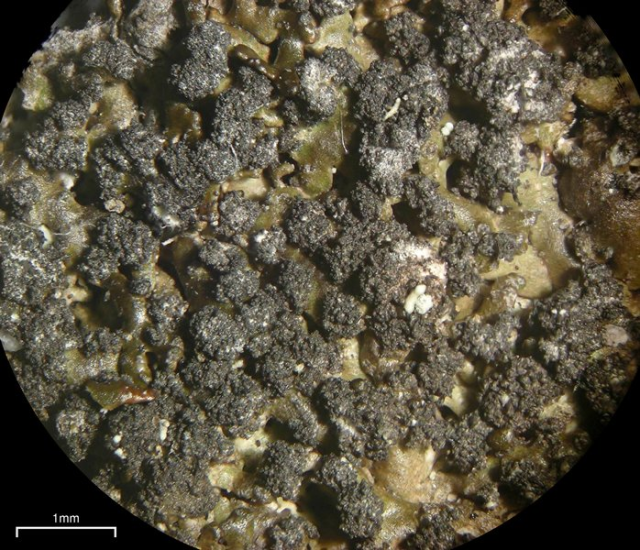
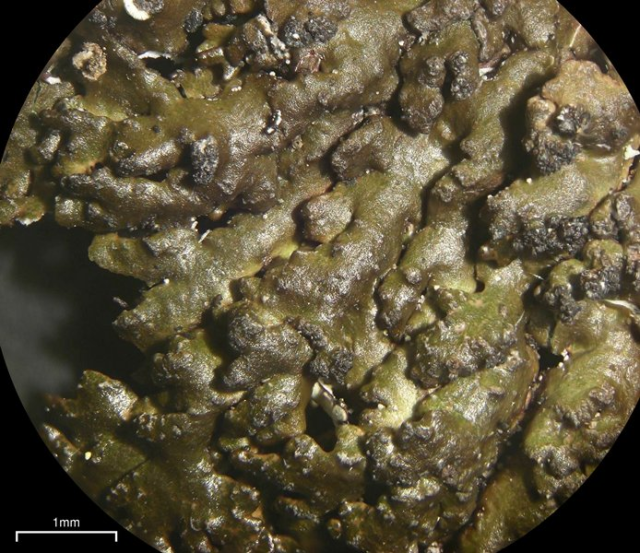




Montanelia disjuncta
Dark lichens are easily overlooked compared to their flashier cousins, but when you get up close and personal, you can see how stunning they truly are! This strongly lobed, foliose lichen grows in rounded rosettes closely attached to vertical, siliceous rock. It has a dark olive to brown to black upper surface, and a dark, rhizinate lower surface. It produces dark brown to black soredia, and only rarely, sorediate-encircled apothecia. M. disjuncta grows in boreal and montane habitats in North America, Europe, northern Asia, and central Africa.



Arthonia trilocularis
Can you believe this little little gray spot is a lichen? It’s true. A. trolocularis is a foliicolous lichen, meaning it grows on the surface of long-lasting leaves.
A little inside peak into Lichenaday HQ–when I search for images of a lichen, a lot of times I get pictures like this:

This is a picture from a botanical collection (The New York Botanical Garden in this one) of a lichen specimen. And a lot of times, these pictures are not that great. Like in this picture, it is hard to know what you are supposed to be looking at because there’s a big, dry, dead leaf with a bunch of splotches on it. And believe it or not, this is one of the better ones I’ve seen! Because A. trilocularis, the subject hear, is kinda just a splotch on a leaf, and this was the only picture of it I could find that actually like, shows *the leaf.* For a lot of other lichens, once they are dried and aged, they don’t look like the living specimen at all, and the pictures are often from such a distance that you can’t tell what the F you are looking at. But those are the only pictures I find for lots of species. I avoid posting them because they are usually not great to look at and not super helpful for field ID purposes, but I thought I’d share this one so you get an idea of the substrate for this little splotchy fella.








Candelariella coralliza
Naming a kid anytime soon? Have you considered the name Coralliza? And they can go by Liza, and people will be like, “oh, like Liza Minnelli?” and they can be like “No, like the lichen.” This crustose lichen is described as coralloid, or coral-like in growth form. It grows in 2 mm thick patches of cracked, grainy, bright yellow thallus. It has flat-disked, yellow apothecia, often with a gray or black tint. C. coralliza is ornithocoprophilic, meaning it likes to grow where there is lots of bird poop! So you can often find it near coasts or high in the mountains, growing on rocks and roofs frequented by perching birds. Maybe not what you want to name your kid after, but maybe it would be a reminder that even beautiful things can some out of shitty situations.




Cora timucua
I’ll be honest with you–not a big fan of April Fool’s day. Maybe because I am gullible, or not clever enough to think of my own pranks. So instead, I am sharing what I *hope* is an elaborate prank lichens are pulling on us–The Timucua Heart Lichen Project.
The Timucua Heart Lichen (Cora timucua) is a species of lichen endemic to Florida and the only species in the genus Cora to have inhabited the United States. It is named after the Native American people who lived in Northeast and North Central portions of what is now Florida. While historically its range included large areas of Florida, the only areas where the lichen has been reported in the second half of the 20th century are the Ocala National Forest and the O’Leno State Park. Despite its showy appearance, the species has not been collected or observed since 1985, so it is at least critically endangered or possibly even extinct. The main goal of the proposed project is to conduct an extensive and cooperative search for the species throughout its historical range and areas where the species could potentially grow, to investigate if it still exists in the wild and if so, to propose actions for its conservation. The search will engage a diverse group of people, including scientific experts, lichen enthusiasts, land managers, and the general public. Cora timucua grew primarily on shrubs in the endangered Florida sand pine scrub ecoregion, of which only 10-15% is estimated to remain intact. Thus, the majority of the search effort will be conducted in that ecoregion.
I hope dearly that this gorgeous pal is just hiding somewhere out there, and we will find it alive and well in due time.
images:source
Haematomma nicoyense
You all and your stupid memes got me to sign up for this Dracula email thing, and so in order to celebrate, I am sharing this “bloody eye” lichen, H. nicoyense! It reminds me of that moment where Johnathan cuts himself while shaving and the Count’s “eyes blazed with a sort of demoniac fury.” Kinda, I mean, these apothecia remind me more of a jelly donut then anything. But I gotta do what I can to keep these cats hip and cool for you kiddos! This crustose lichen was described in 2006, and thus far has only been found in a few montane forests in Central America. Tropical lichens are largely understudied, which is such a pity when they are out there being as adorable as this lil guy. If only more people cared about lichens and lichen research. But hey, if we can revive interest in a 125 year old gothic novel, surely we can get people interested in cuties like these right?
images:source
info:source
Post link
Ephebe hispidula
Hairy thread lichen
This lichen is very texture. Like think of a texture, and E. hispidula probably has it. Descriptions I have found include pannose (the texture of felt or woolen cloth), spiny, filamentous, hair-like, beard-like, jelly-like (only when moist), and my personal favorite, ‘Brillo-pad’ texture. It has a dark olive to brown to black, fruticose thallus of short, lateral branchlets. E. hispidula grows on damp, siliceous rocks in the northern hemisphere, adding a little pop of texture to the world since probably like, 40 MYA or whatever.
Post link
Lecanora mughicola
So often when I see the scientific names of lichens, I wonder if the people who named them bothered trying to say them out loud. I think mughicola sounds like a sneeze. Not necessarily a bad name, but maybe something easier to pronounce next time, ok guys? This crustose lichen has a glossy, beige-yellow, bumpy thallus. It produces apothecia with an undulating margin and orange-brown to dark brown discs which often appear paler due the a layer of chalky pruina. L. mughicola grows on the lignum (woody tissue under the bark) of conifers in boreal forests. It has been found in North America and Europe, but its range likely extends into northern Asia.
Post link
Phaeophyscia rubropulchra
Orange-cored shadow lichen
This foliose lichen grows in small roundish-patches or narrow lobes. The upper surface varies in color from gray to brown when dry (darker in shaded areas), becoming bright green when moist. Lobe tips and occasionally surface area covered in coarse soredia. The lower surface is black with thick black rhizines. A distinctive feature of P. rubropulchra is the bright red-orange medullary layer at its core. This is due to the presence of skyrin. What is skyrin? I don’t know what do I look like a chemist? For our purposes, it makes red. P. rubropulchra grows on trees and rocks in eastern North America, eastern China and Russia, and Japan. Apparently it is a common snack for slugs, which doesn’t really surprise me because looking at that medulla makes me think of flamin-hot cheetos and now I’m hungry. Thanks, lichens.
Post link







Porpidia carlottiana
I have been exhausted and down lately, but looking at P. carlottiana is restoring my soul and clearing just a little bit of fog off my brain. Enjoy!
Pyrenodesmia albovariegata
Met a little girl last week with red hair and complimented her on it. She said she never saw people with her hair color, and I told her that there are lots of redheads in my family and proceeded to show her pictures. I don’t know if it made her feel seen, or made her feel a little less special (oops, sorry kid), but it got me thinking. I know you may look at P. albovariegata and think, psh, whatever, a boring gray lichen. But listen, this guy is in the Teloschistaceae family, and most of those lichens are bright orange/red. P. albovariegata is actually an original! A stand out! The gray sheep of the family. Someone’s ordinary can totally be someone else’s extraordinary! Keep that in mind when seeing the world everyday and you will never be bored.
info:source
Post link
Peltigera venosa
Fan lichen
I have never wanted chocolate chip cookies more in my entire life than I do after staring at P. venosa. This lichen has small overlapping or larger fan-shaped lobes. The upper surface is bright green when moist, and a dull gray when dry. Apparently there is also a darker blue-green morphotype with smaller, scale-like lobes, but I couldn’t find any pictures of it. This variation is dependent on the presence of a green algae photobiont or a blue-green cyanobacterial primary photobiont. It appears that the green algae associated morphotype is more common, though apparently they can grow in the same patch! The lower surface is pale with prominent veins and dark spots called cephalodia which contain a secondary, cyanobacterial photobiont. It produces large, circular apothecia along the leaf margins which are flat, smooth, and dark brown in color. P. venosa grows on moist, mossy soil at high elevations in the northern hemisphere. One of many Peltigera lichens, this one is the easiest to identify due to its characteristic leaf shape, venation on the lower surface, and distinctive apothecia. So go out there and find them! And maybe make some chocolate cookies and bring them by my place please? Thanks.
Post link
Polycauliona luteominia
Red firedot lichen
This crustose lichen has a thin, immersed basal thallus, and so generally appears as a smattering of round apothecia. The apothecia have a prominent margin, and a flat or concave disc. P. luteominia comes in two varieties: var. luteominia, which has orange apothecia, and var. bolanderi, which has bright red apothecia. Both can be found on rock and soil near the Pacific coast of North America.
info:source
Post link
Koerberiella wimmeriana
And this time
We’re going to get *BUMPY*
K. wimmeriana is a crustose lichen with a gray or pink-gray thallus made up of rounded, bulbous protrusions. It produces cylindrical isidia, and brown-disked apothecia. It colonizes siliceous rock near water in sub-alpine areas of the northern hemisphere.
Post link
Opegrapha vulgata
I would have never thought lichens could be vulgar, but here it is guys–the most vulgar lichen out there. O. vulgata is a script lichen, meaning that it has long, slit-like, lirellate apothecia. Also I hate the word slit. Anyhow, O. vulgata has a smooth, pale gray to tan, green-tinted thallus. Its apothecia are black, but variable in shape–from straight to curving to squiggly to star-like. So how to identify it in comparison with the vast array of other script lichens? By its longer conidia, of course! What’re conidia? Conidia are well, it’s complicated. They are tiny, asexual, spores that serve as the male gametes. So like, sperm! Kinda. Don’t worry too much about. All you gotta know is that O. vulgata’s conidia are really long. Now you know why it’s so vulgar! This lichen grows on smooth tree bark in humid, shaded areas throughout the world.
Post link








Stereocaulon botryosum
Cauliflower foam lichen
Thinking about it, it’s weird that so many things in the world ended up being cauliflower shaped–there’s cauliflower, cauliflower geodes, cauliflower mushrooms (genus Sparassis), cauliflower corals (genus Pocillopora), this lichen, etc. Nature loves a roundish, warty, white blob, I guess. Or humans do, and that’s why we bred cauliflower in the first place and started naming things after it. Well S. botryosum may appear cauliflower-like, but it is a lichen, meaning it is a symbiotic association between a fungi and in this case, a green algae. It grows on siliceous rock and soil in Arctic and Alpine habitats in North America and Europe.







Phaeophyscia endococcinodes
Starburst shadow lichen
Being an American living in Germany, I do not have access to many of the snack foods and candies I grew up with, and they often slip my mind. So imagine reading the word “starburst” and remembering that Starburst candy exists out there in the world somewhere and you do not have access to it. Trying so hard to focus on this lichen but all I can think about are tiny chewy fruit cubes … Anyway, P. endococcinodes is a foliose lichen with a gray-brown to gray-green upper surface and frequent, black-disked apothecia. It grows on rock and occasionally bark in Africa, Asia, Europe, and North America. It has a characteristic red medulla (inner layer made up of fungal hyphae) which I imagine is the same color as a red starburst, which is probably the best original Starburst flavor, though I am partial to orange myself. Wait, lichens, yes. And this is how P. endococcinodes got its species name (“endo-” meaning inner and “coccin” meaning scarlet and “-odes” meaning to have the nature of).
Brand new moss necklaces up in my shop today! I’ll have a fancy little picture later but here’s a preview of a few of the new moss necklace shapes I’ve made!
Post link
Hey folks! At long last, I’m putting out a new update with a bunch of new and improved moss necklaces!
I’ve re-made two old molds, the square moss necklace mold as well as all three sizes of my crystal mold, now with a new technique that finally, finally, has perfectly smooth, flat sides and perfect edges. I’m so happy to have finally perfected my crystalline pieces. They’re sharp enough now to easily refract light.
Tomorrow is going to be a moss only update, with a few of these crystals and rectangular prisms, as well as a healthy serving of my tried and true small moss necklaces, $15 each.
Post link
Moss mindfulness moment, with babbling brook bonus.
The trees on this hike were the mossiest I’ve ever come across in Austin. Grateful to encounter the unexpected that transports as if to a different place. But also, have I been choosing the wrong trails all this time…!
#bryology #touchallthemoss #hiking #nature #explore #hike #moss #trail #austin #outdoors #creation #atx #wander
https://www.instagram.com/p/CZx8XaqOZwd/?utm_medium=tumblr
Post link
Science asks us to learn about organisms, traditional knowledge asks us to learn from them.
Mosses are ancient, they’ve figured out how to live well on the earth.
They are storytellers.
In their simplicity, in the power of being small, mosses have become so successful because they live in these tiny layers on rocks, on trees, they work with the natural forces that lay over every surface of the world.
They are examples of not only surviving but flourishing by working with natural processes.
Mosses are superb teachers about living within your means.
Mosses have, in the ecological sense, very low competitive ability, because they’re small, because they don’t grab resources very efficiently. This means that they have to live in the interstices, where the dominant plants can’t live.
But the way that they do this really brings into question the whole premise that competition is what really structures biological evolution and biological success.
Mosses are not good competitors at all and yet they are the oldest plants on the planet. They have persisted here for 350 million years… so they ought to be doing something right.
One of those ‘somethings’ is their ability to cooperate with one another.
Their ability to share the limited resources that they have to really give more than they take. Mosses build soil, they purify water, they are like the coral reefs of the forest—they make homes for this myriad of cool, little invertebrates who live there.
They are engines of biodiversity. They do all of these things and yet they are only one centimeter tall.
This is a time to take a lesson from mosses.
-Some wisdom from Robin Wall Kimmerer, native storyteller and bryologist (studier of mosses).
#ancestralwisdom #robinwallkimmerer #braidingsweetgrass #indigenousknowledge #gatheringmoss #bryology #moss #biodiversity
https://www.instagram.com/p/CGkWaEQhpAm/?igshid=agu73912p5nf
Post link























